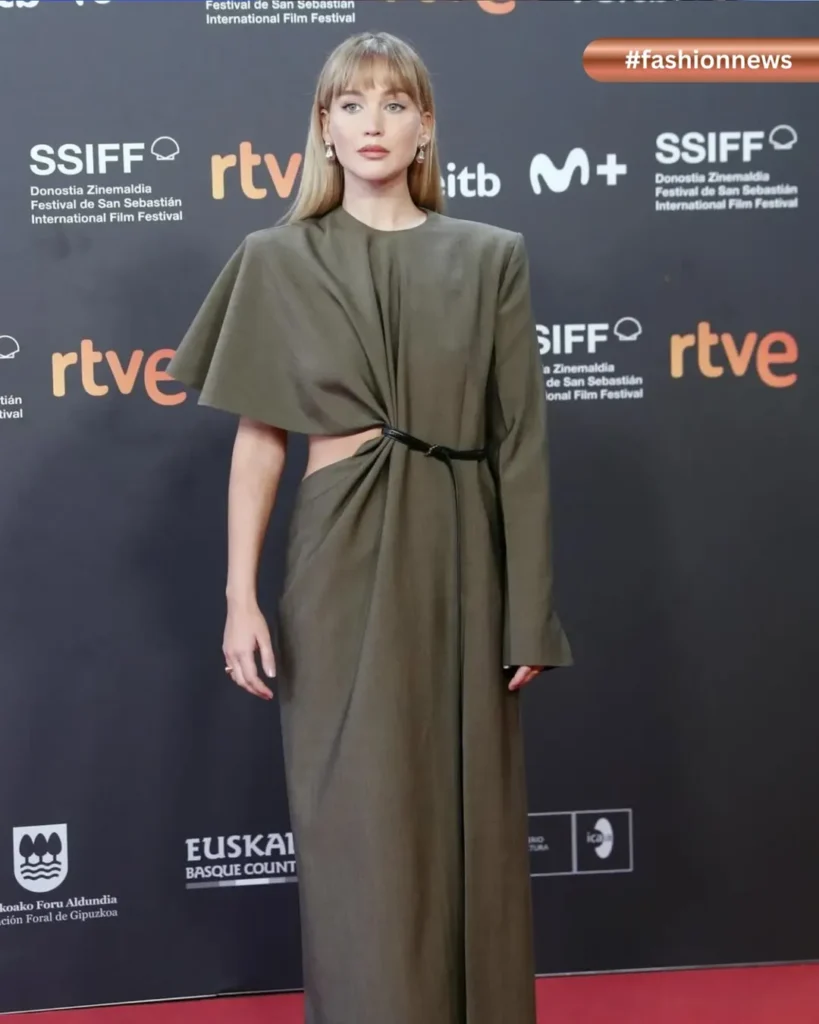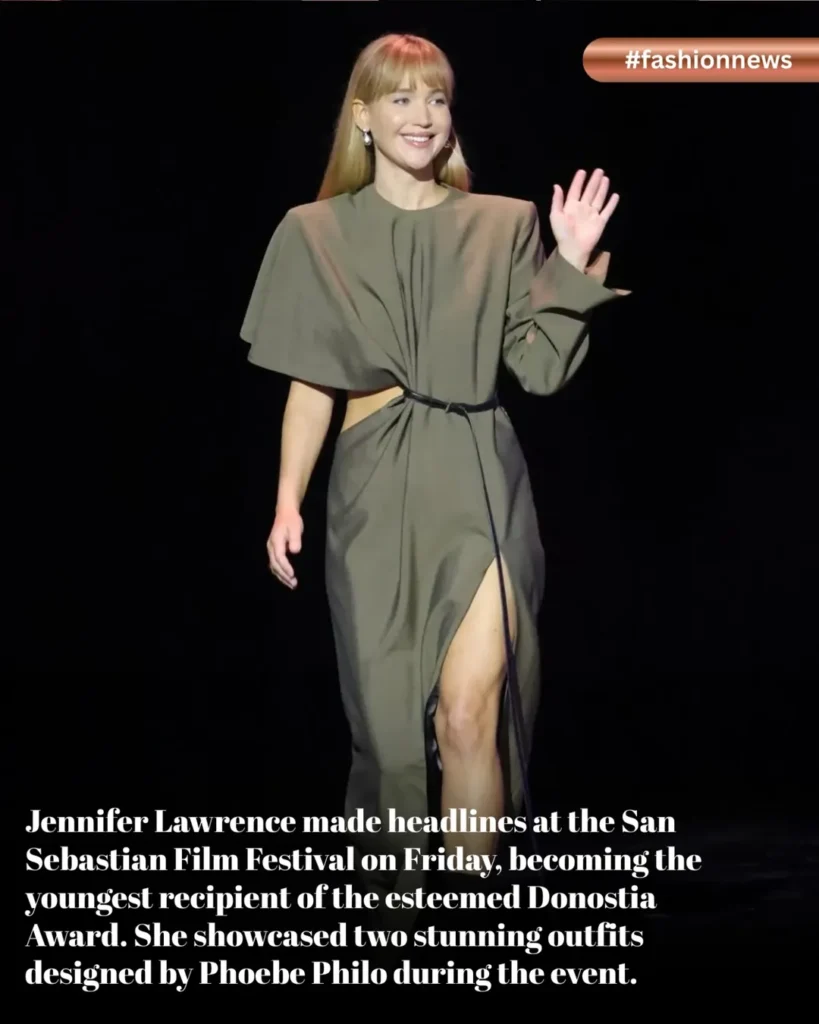Youngest Ever, But Never Hesitant
It was a clear night in San Sebastián when the Kursaal Theatre lights shone brightest for Jennifer Lawrence. At age 35 she accepted the Donostia Lifetime Achievement Award—or simply the Donostia Award—becoming the youngest performer to ever receive it. The honor, which celebrates an artist’s contribution to cinema, is typically reserved for those deep into their careers. But Lawrence’s body of work, from indie emotional roles to blockbuster megahits, has earned her that distinction early. Her speech brimmed with gratitude — she praised the art of storytelling, the thrill of cinema festivals, and even the Basque cuisine that drew her to San Sebastián.
She was there not just to receive, but to show up — fully visible, fully herself. Mid‑career, with wins and losses, beginnings and ends, she stood under those lights and carried not the weight of myth but the warmth of sincerity.
Two Looks, One Statement: Dressing With Intention

Jennifer didn’t settle for one outfit. She opened her San Sebastián day with a photocall and closed it with her big evening moment. Both ensembles came from Phoebe Philo, a designer known for architectural precision, quiet power, and thoughtful minimalism. The contrast between the two looks was part of the message: strength in form, daring in cut, elegance in poise.
Morning Minimalism: Black, White, and Poised
For the photocall of Die, My Love earlier in the day, Jennifer appeared in a look that played with structure and drama in understated style. A black satin T‑shirt from Philo’s new “Collection D,” with rolled sleeves that revealed a crisp white underside, paired with matching satin wide trousers. The shirt extended back into a long dramatic train. It nodded to classic runway excess, but she wore it like it was a practical statement — movement, proportion, balance. Jewelry minimal. Styling neat. Hair pulled back into a low bun — composed, collected, ready.
It was almost a rehearsal for the night‑look; a calibration of mood. The dark tones, the satin, the train — all elements that reference grandeur without trying too hard. It set the tone that this day would be about more than aesthetics — about presence.
Evening Drama: Green, Cut‑Out, and Asymmetry
Later that evening, during the Donostia ceremony and the premiere of Die, My Love, Jennifer chose something more sculptural, more daring. She stepped out in a custom Phoebe Philo gown in a deep, rich olive‑green wool. One sleeve was long and dramatic, the other short. The gown featured a large side cut‑out, exposing her midriff and lower back, along with a thigh‑high slit. A thin black belt cinched at the waist, amplifying structure and silhouette. Her hair fell straight with bangs — the haircut adding a sharpness to the look. Make‑up was kept natural, letting the cut‑outs, color, and form make the statement.
This look was riskier. It exposed skin in unexpected places, opened up shape in an otherwise structured fabric. The asymmetry was bold. And yet, it was balanced — the long sleeve offsetting the short, the slit balancing the cut‑out. She moved in it with confidence, embraced its drama, and let it carry both her performance and the honor she was receiving.
Fashion as Narrative, Not Just Glamour

What makes these looks more than just red carpet highlights is how they reflect who Jennifer Lawrence is right now: an artist with achievements, but still very much in motion. The Donostia Award often recognizes long careers; her win suggests both that her past matters and that her present is potent.
Her fashion choices felt like a conversation about identity: maturity, agency, reinvention. The cut‑out gown didn’t feel gratuitous. The minimal morning look didn’t feel subdued. Together they framed a day where Jennifer wasn’t simply receiving an award — she was owning the narrative. The clothes, the design, the styling — all pivoted around that ownership.
Reactions, Resonance & the Memory She Built
The fashion world responded. Critics noted how the green gown’s architecture felt new — a mix of strength and exposure in ways not often combined. Fans praised the bangs‑reveal and the confidence of her silhouette. Headlines called the cut‑out daring, compared the asymmetry to tailors’ art. Social media lit up with admiration, memes, commentary — but most of all, respect.
In a festival where many gowns blur together, this one stood out. Not because of extravagance, but because of intention. Her acceptance speech echoed that: this is more than recognition of past roles; it’s a reminder that stories still matter, that standing in front of audiences still terrifies and thrills, that even in honors, there’s work left to do.
Beyond the Green Dress and Into the Horizon
Lawrence accepted the Donostia Award, yes. But she also premieres Die, My Love at the same festival — a film she’s deeply invested in, both as actor and producer. She’s coming off challenges, transitions, motherhood, public life’s demands. But under that olive green wool, under those sharp bangs and confident seams, she seems further from retreat and closer to fully inhabiting her voice — cinematic, emotional, stylish.
The youngest Donostia recipient isn’t just a trivia point. It’s a marker. A signpost pointing toward the rest of her career. Her red carpets will be watched not just for glam, but for identity. Her film choices observed not just for star power, but for risk, for artistic weight. Her style recognized not just as fashion, but as expression.
Jennifer Lawrence at San Sebastián didn’t just win an award. She claimed a moment. A day of image, voice, gratitude, daring. And she did it on her own terms. The gowns, the green, the cut‑outs — they will be remembered. Not because they were loud, but because they meant something.
Sometimes, fashion becomes legacy. Sometimes, awards become part of story. And here, combining both, she made sure this night will stay in memory. longer than any headline.

